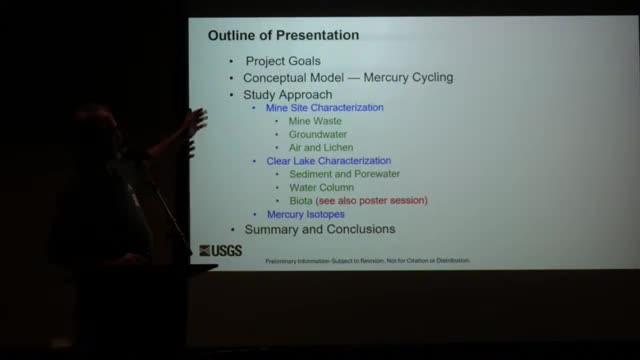Scientists Unravel Complex Mercury Cycle in Clear Lake
August 16, 2024 | Events, Lake County, California
This article was created by AI summarizing key points discussed. AI makes mistakes, so for full details and context, please refer to the video of the full meeting. Please report any errors so we can fix them. Report an error »

In a recent government meeting, scientists presented their ongoing research into mercury contamination in Clear Lake, focusing on the impact of the nearby Sulfur Bank Mercury Mine. The study aims to identify the sources of mercury in the lake's food web, particularly through the use of mercury isotopes, a relatively new scientific tool.
The research is part of a broader effort to support the Environmental Protection Agency (EPA) in evaluating the effectiveness of remedial actions at the mine site. Key goals include understanding the interactions between contaminants from the mine and the lake's ecosystem, particularly the formation of methylmercury, a toxic organic form of mercury that bioaccumulates in fish.
The presentation highlighted the complexity of the mercury cycle, detailing how mercury from the mine can enter the lake and subsequently the food web. It was noted that methylmercury concentrations increase significantly as one moves up the food chain, with fish showing levels that can be a million times higher than those found in the water.
Researchers have been collecting samples from both the mine site and Clear Lake to analyze mercury concentrations and assess the potential for disrupting the methylation cycle, which could help reduce mercury levels in fish. The study also involves the calibration of a 3D hydrodynamic model developed by UC Davis, which will incorporate data on mercury bioaccumulation.
The meeting underscored the importance of understanding the pathways through which mercury enters the ecosystem, as well as the role of microbial activity in the methylation process. Preliminary findings indicate that methylmercury formation is more prevalent under anoxic conditions, which can occur in the lake's sediments.
In addition to sediment analysis, researchers are employing innovative techniques, such as using lichens as bioindicators of mercury levels in the environment. Air sampling around the mine site has revealed elevated mercury concentrations, prompting further investigation into the potential impacts on surrounding watersheds.
Overall, the research aims to provide critical insights into mercury contamination in Clear Lake, informing future remediation efforts and public health initiatives. The findings will be shared with the community through poster sessions and ongoing updates as the study progresses.
The research is part of a broader effort to support the Environmental Protection Agency (EPA) in evaluating the effectiveness of remedial actions at the mine site. Key goals include understanding the interactions between contaminants from the mine and the lake's ecosystem, particularly the formation of methylmercury, a toxic organic form of mercury that bioaccumulates in fish.
The presentation highlighted the complexity of the mercury cycle, detailing how mercury from the mine can enter the lake and subsequently the food web. It was noted that methylmercury concentrations increase significantly as one moves up the food chain, with fish showing levels that can be a million times higher than those found in the water.
Researchers have been collecting samples from both the mine site and Clear Lake to analyze mercury concentrations and assess the potential for disrupting the methylation cycle, which could help reduce mercury levels in fish. The study also involves the calibration of a 3D hydrodynamic model developed by UC Davis, which will incorporate data on mercury bioaccumulation.
The meeting underscored the importance of understanding the pathways through which mercury enters the ecosystem, as well as the role of microbial activity in the methylation process. Preliminary findings indicate that methylmercury formation is more prevalent under anoxic conditions, which can occur in the lake's sediments.
In addition to sediment analysis, researchers are employing innovative techniques, such as using lichens as bioindicators of mercury levels in the environment. Air sampling around the mine site has revealed elevated mercury concentrations, prompting further investigation into the potential impacts on surrounding watersheds.
Overall, the research aims to provide critical insights into mercury contamination in Clear Lake, informing future remediation efforts and public health initiatives. The findings will be shared with the community through poster sessions and ongoing updates as the study progresses.
View full meeting
This article is based on a recent meeting—watch the full video and explore the complete transcript for deeper insights into the discussion.
View full meeting
